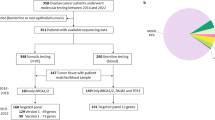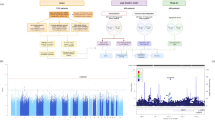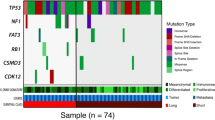Abstract
Germline variants in the 3′ untranslated region (3′UTR) of cancer genes disrupting microRNA (miRNA) regulation have recently been associated with cancer risk. A variant in the 3′UTR of the KRAS oncogene, referred to as the KRAS variant, is associated with both cancer risk and altered tumor biology. Here, we test the hypothesis that the KRAS variant can act as a biomarker of outcome in epithelial ovarian cancer (EOC), and investigate the cause of altered outcome in KRAS variant-positive EOC patients. As this variant seems to be associated with tumor biology, we additionally test the hypothesis that this variant can be directly targeted to impact cell survival. EOC patients with complete clinical data were genotyped for the KRAS variant and analyzed for outcome (n=536), response to neoadjuvant chemotherapy (n=125) and platinum resistance (n=306). Outcome was separately analyzed for women with known BRCA mutations (n=79). Gene expression was analyzed on a subset of tumors with available tissue. Cell lines were used to confirm altered sensitivity to chemotherapy associated with the KRAS variant. Finally, the KRAS variant was directly targeted through small-interfering RNA/miRNA oligonucleotides in cell lines and survival was measured. Postmenopausal EOC patients with the KRAS variant were significantly more likely to die of ovarian cancer by multivariate analysis (hazard ratio=1.67, 95% confidence interval: 1.09–2.57, P=0.019, n=279). Perhaps explaining this finding, EOC patients with the KRAS variant were significantly more likely to be platinum resistant (odds ratio=3.18, confidence interval: 1.31–7.72, P=0.0106, n=291). In addition, direct targeting of the KRAS variant led to a significant reduction in EOC cell growth and survival in vitro. These findings confirm the importance of the KRAS variant in EOC, and indicate that the KRAS variant is a biomarker of poor outcome in EOC likely due to platinum resistance. In addition, this study supports the hypothesis that these tumors have continued dependence on such 3′UTR lesions, and that direct targeting may be a viable future treatment approach.
This is a preview of subscription content, access via your institution
Access options
Subscribe to this journal
Receive 50 print issues and online access
$259.00 per year
only $5.18 per issue
Buy this article
- Purchase on Springer Link
- Instant access to full article PDF
Prices may be subject to local taxes which are calculated during checkout





Similar content being viewed by others
References
Jemal A, Siegal R, Ward E, Hao Y, Xu J, Thun MJ . (2009). Cancer statistics, 2009. CA Cancer J Clin 59: 225–249.
Parmar MK, Ledermann JA, Colombo N, du Bois A, Delaloye JF, Kristensen GB et al. (2003). Paclitaxel plus platinum-based chemotherapy versus conventional platinum-based chemotherapy in women with relapsed ovarian cancer: the ICON4/AGO-OVAR-2.2 trial. Lancet 361: 2099–2106.
Pfisterer J, Plante M, Vergote I, du Bois A, Hirte H, Lacave AJ et al. (2006). Gemcitabine plus carboplatin compared with carboplatin in patients with platinum-sensitive recurrent ovarian cancer: an intergroup trial of the AGO-OVAR, the NCIC CTG, and the EORTC GCG. J Clin Oncol 24: 4699–4707.
Herzog T, Pothuri B . (2006). Ovarian cancer: a focus on management of recurrent disease. Nat Clin Pract Oncol 3: 604–611.
Esquela-Kerscher A, Slack F . (2006). Oncomirs—microRNAs with a role in cancer. Nat Rev Cancer 6: 259–269.
Iorio M, Visone R, Di Leva G, Donati V, Petrocca F, Casalini P et al. (2007). MicroRNA signatures in human ovarian cancer. Cancer Res 67: 8699–8707.
Zhang L, Volinia S, Bonome T, Calin GA, Greshock J, Yang N et al. (2008). Genomic and epigenetic alterations deregulate microRNA expression in human epithelial ovarian cancer. Proc Natl Acad Sci USA 105: 7004–7009.
Mezzanzanica D, Bagnoli M, De Cecco L, Valeri B, Canevari S . (2010). Role of microRNAs in ovarian cancer pathogenesis and potential clinical implications. Int J Biochem Cell Biol 42: 1262–1272.
van Jaarsveld M, Helleman J, Berns E, Wiemer E . (2010). MicroRNAs in ovarian cancer biology and therapy resistance. Int J Biochem Cell Biol 42: 1282–1290.
Eitan R, Kushnir M, Lithwick-Yanai G, David MB, Hoshen M, Glezerman M et al. (2009). Tumor microRNA expression patterns associated with resistance to platinum based chemotherapy and survival in ovarian cancer patients. Gynecol Oncol 114: 253–259.
Lu L, Schwartz P, Scarampi L, Rutherford T, Canuto EM, Yu H et al. (2011). MicroRNA let-7a: a potential marker for selection of paclitaxel in ovarian cancer management. Gynecol Oncol 122: 366–371.
Chen K, Song F, Calin GA, Wei Q, Hao X, Zhang W et al. (2008). Polymorphisms in microRNA targets: a gold mine for molecular epidemiology. Carcinogenesis 29: 1306–1311.
Chin LJ, Ratner E, Leng S, Zhai R, Nallur S, Babar I et al. (2008). A SNP in a let-7 microRNA complementary site in the KRAS 3′ untranslated region increases non-small cell lung cancer risk. Cancer Res 68: 8535–8540.
Ratner E, Lu L, Boeke M, Barnett R, Nallur S, Chin LJ et al. (2010). A KRAS-variant in ovarian cancer acts as a genetic marker of cancer risk. Cancer Res 15: 6509–6515.
Paranjape T, Heneghan H, Lindner R, Keane FK, Hoffman A, Hollestelle A et al. (2011). A 3′-untranslated region KRAS variant and triple-negative breast cancer: a case-control and genetic analysis. Lancet Oncol 12: 377–386.
Hollestelle A, Pelletier C, Hooning M, Crepin E, Schutte M, Look M et al. (2011). Prevalence of the variant allele rs61764370 T>G in the 3′UTR of KRAS among Dutch BRCA1, BRCA2 and non-BRCA1/BRCA2 breast cancer families. Breast Cancer Res Treat 128: 79–84.
Christensen BC, Moyer BJ, Avissar M, Ouellet LG, Plaza SL, McClean MD et al (2009). A let-7 microRNA binding site polymorphism in the KRAS 3′UTR is associated with reduced survival in oral cancers. Carcinogenesis 30: 1003–1007.
Graziano F, Canestrari E, Loupakis F, Ruzzo A, Galluccio N, Santini D et al. (2010). Genetic modulation of the let-7 microRNA binding to KRAS 3′-untranslated region and survival of metastatic colorectal cancer patients treated with salvage cetuximab-irinotecan. Pharmacogenomics J 10: 458–464.
Singh A, Greninger P, Rhodes D, Koopman L, Violette S, Bardeesy N et al. (2009). A gene expression signature associated with ‘K-Ras addiction’ reveals regulators of EMT and tumor cell survival. Cancer Cell 15: 489–500.
Peters D, Freund J, Ochs R . (2005). Genome-wide transcriptional analysis of carboplatin response in chemosensitive and chemoresistant ovarian cancer cells. Mol Cancer Ther 4: 1605–1616.
Helland A, Anglesio MS, George J, Cowin PA, Johnstone CN, House CM et al. (2011). Deregulation of MYCN, LIN28B and LET7 in a molecular subtype of aggressive high-grade serous ovarian cancers. PLoS One 6: e18064.
ACS (2010). Cancer facts & figures 2010. Cancer Facts & Figures. ACS: Atlanta, GA, pp 1–56.
Salzman DW, Weidhaas JB . (2011). miRNAs in the spotlight: Making ‘silent’ mutations speak up. Nat Med 17: 934–935.
Pharoah P, Palmieri R, Ramus SJ, Gayther SA, Andrulis IL, Anton-Culver H et al. (2011). The role of KRAS rs61764370 in invasive epithelial ovarian cancer: implications for clinical testing. Clin Cancer Res 17: 3742–3750.
Li M, Balch C, Montgomery JS, Jeong M, Chung JH, Yan P et al. (2009). Integrated analysis of DNA methylation and gene expression reveals specific signaling pathways associated with platinum resistance in ovarian cancer. BMC Med Genomics 2: 1755–1758.
Youn CK, Kim MH, Cho HJ, Kim HB, Chang IY, Chung MH et al. (2011). Oncogenic H-Ras up-regulates expression of ERCC1 to protect cells from platinum-based anticancer agents. Cancer Res 64: 4849–4857.
Sasaki H, Hikosaka Y, Kawano O, Moriyama S, Yano M, Fujii Y et al. (2011). Evaluation of Kras gene mutation and copy number gain in non-small cell lung cancer. J Thorac Oncol 6: 15–20.
Lu L, Katsaros D, Rigault de la Longrais I, Sochirca O, Yu H . (2007). Hypermethylation of let-7a-3 in epithelial ovarian cancer is associated with low insulin-like growth factor-ii expression and favorable prognosis. Cancer Res 67: 10117–10122.
Smyth G . (2005). Limma. in Gentleman R, Dudoit VS, Irizarry R & Huber W. (eds) Bioinformatics and Computational Biology Solutions using R and Bioconductor. Springer: New York, pp. 397–420.
Kaplan E, Meier P . (1958). Nonparametric estimation from incomplete observations. J Am Stat Assoc 53: 457–481.
Mantel N . (1966). Evaluation of survival data and two new rand order statistics arising in its consideration. Cancer Chemother Rep 50: 163–170.
Cox D . (1972). Regression models and life tables. J R Stat Soc 34: 187–220.
Cox D . (1970). The Analysis of Binary Data. Methuen, London.
Acknowledgements
We thank JL and his group for supplying the cell line-associated chemosensitivity data. We appreciate Greg Wilhoite for performing the TaqMan assay and Josef Herzog for processing samples for the City of Hope. We also appreciate Discovery to Cure at Yale University for samples and Jeff Boyd for supplying the BG1 cell line for targeting studies. ER was supported by a Women's Reproductive Health Research (WRHR) Career Development Program grant (5K12HD047018-08). FS and JW were supported by a Mary Kay Foundation Grant, and an R01 from the NCI (CA131301-01A1). JW also was supported by a K08 grant (CA124484). AS was supported by R01CA122728. SLN is partially supported by the Morris and Horowitz Families Endowed Professorship and NIH R01CA74415. JNW and SS are supported by RC4CA153828 from the National Cancer Institute and the Office of the Director, National Institutes of Health, and also by funding from the Markel Foundation. We also appreciate support from the Shannon Family Foundation, the Segesta family and donations made in memory of Jennifer Casey.
Author information
Authors and Affiliations
Corresponding author
Ethics declarations
Competing interests
JW and FS are co-founders of a company that has licensed IP regarding the KRAS variant from Yale University. They both own stock in this company.
Additional information
Supplementary Information accompanies the paper on the Oncogene website
Supplementary information
Rights and permissions
About this article
Cite this article
Ratner, E., Keane, F., Lindner, R. et al. A KRAS variant is a biomarker of poor outcome, platinum chemotherapy resistance and a potential target for therapy in ovarian cancer. Oncogene 31, 4559–4566 (2012). https://doi.org/10.1038/onc.2011.539
Received:
Revised:
Accepted:
Published:
Issue Date:
DOI: https://doi.org/10.1038/onc.2011.539
Keywords
This article is cited by
-
Identification of seven hypoxia-related genes signature and risk score models for predicting prognosis for ovarian cancer
Functional & Integrative Genomics (2023)
-
The KRAS-variant and its impact on normal breast epithelial cell biology
Cell Death & Differentiation (2019)
-
KRAS polymorphisms are associated with survival of CRC in Chinese population
Tumor Biology (2016)
-
Risk prediction model for epithelial ovarian cancer using molecular markers and clinical characteristics
Journal of Ovarian Research (2015)
-
Role of KRAS-LCS6 polymorphism in advanced NSCLC patients treated with erlotinib or docetaxel in second line treatment (TAILOR)
Scientific Reports (2015)



